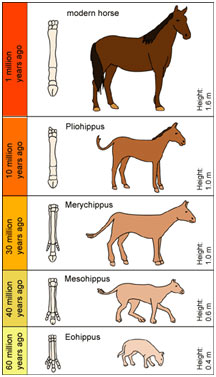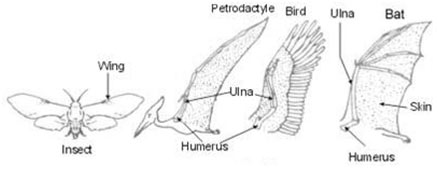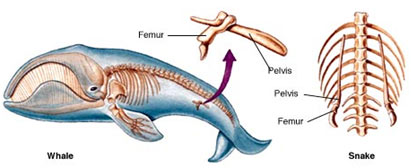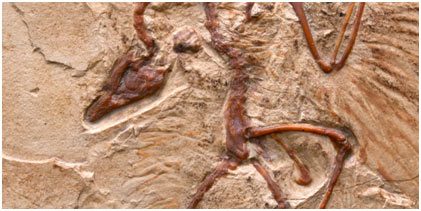Overview
Evolution is a remodeling process in which ancestral structures that function in one capacity become modified as they take on new functions.
- Fossils provide visual records in a complete series showing the evolution of an organism.
- Most fossils are found in sedimentary rocks and the oldest known fossils are of prokaryotes.
- Biogeographic studies show that life in different parts of the world has distinctive evolutionary histories.
- Modern evolutionary biologists recognize the importance of geological events.
- Similarities among the structures of animals occur due to common evolutionary origin.
- Closely related organisms go through similar stages in embryonic development.
- Animals have homologous biochemical processes like homologous structures; so, molecular biology has provided a lot of important information about evolutionary relationships.
- 1) Evidence of Biological Evolution
- 2) Biogeography
- 3) The Fossil Record
- 4) Comparative Anatomy
- 5) Comparative Embryology
- 6) Molecular Biology
- 7) MCQs with Answers
- 8) Frequently Asked Questions (FAQs) – Evidence of Biological Evolution:
- 9) Wrapping up Evidences of Biological Evolution Tutorial
- 10) You may also like to learn:
Evidence of Biological Evolution
Evolution is a scientific theory supported by an overwhelming quantity of evidence. Some Christians fear that accepting the theory implies rejecting God as a developer. But that just does not follow. Christians accept scientific theories about the weather conditions, the development of mountains, and even the conception and development of specific human beings while still acknowledging that God is the creator and sustainer of these things.
So, providing a scientific description of a process does not eliminate a genuine theological description of the procedure too. Advancement leaves observable indications. Darwin’s theory of evolution was mainly based on the evidence from the geographical distribution of species and from the fossil record. Nevertheless, there has been much evidence as biology advances. Discoveries continue to verify the evolutionary view of life. Let us discuss now a few of the pieces of evidence.
Biogeography
The geographic distribution of organisms in the world follows patterns that are best explained by development in conjunction with the motion of tectonic plates over geological time. Broad groups that developed before the breakup of the supercontinent Pangaea (about 200 million years ago) are distributed worldwide.
Groups that evolved considering that the break up appear uniquely in regions of the planet, for example, the unique flora and animals of northern continents that formed from the supercontinent Laurasia and of the southern continents that formed from the supercontinent Gondwana. The existence of Proteaceae in Australia, southern Africa, and South America is best discussed by the plant family’s existence there before the southern supercontinent Gondwana breaking up.
Consider armadillos, the armored mammals that live just in America. The evolutionary view of biogeography forecasts that modern armadillos are modified descendants of earlier forms that inhabited these continents, and the fossil record confirms that such forefathers existed.
The Fossil Record
Fossils are either the actual remains or – traces of organisms that lived in ancient geological times. The organism may be embedded in the sand, resin, or ice, or an impression or cast is made from the body parts, the tissue being changed or petrified by silica or calcium carbonate minerals. The majority of fossils are discovered in sedimentary rocks.
The succession of fossil forms is strong evidence in favor of evolution. It supplies a visual record in a complete series showing the evolution of an organism. For instance, evidence from biochemistry, molecular biology, and cell biology positions prokaryotes as the forefathers of all life, and predicts that bacteria need to precede all eukaryotic life in the fossil record. Certainly, the earliest known fossils are prokaryotes.
Another example is the chronological look of the different classes of vertebrate animals in the fossil record. Fossil fishes, the earliest vertebrates, with amphibians next, followed by reptiles, then mammals and birds. This series follows the history of vertebrate descent. The evolution of the horse provides an example of such a history.

Comparative Anatomy
Physiological similarities between species grouped in the same taxonomic classification bring another support to the theory of the Descent with the modification. For instance, the same skeletal components comprise the forelimbs of humans, cats, whales, bats, and all other mammals, although these appendages have different functions.
The basic similarity of these forelimbs is the consequence of mammals from a common forefather. The arms, wings, clippers, and forelegs of different mammals are variations on a common physiological theme that has been modified for divergent functions. The resemblance in characteristics arising from common origins is referred to as homology, and such physiological signs of development are called homologous structures.
Comparative anatomy supports that evolution is a remodeling process in which ancestral structures that operated in one capability ended up being modified as they took on new functions. The lower parts of a lowering plant are homologous. They are considered to have evolved from leaves, to form sepals, petals, stamens, and carpels.
Homologous organs are functionally different but structurally alike e.g., the Forelimbs of humans, bats, horses, whales, and so on are examples of divergent evolution.

Analogous organs are functionally alike but structurally different e.g., wings of a bat, birds, insects, and so on are examples of convergent evolution.

Vestigial organs are historic remnants of structures that had essential functions in ancestors but are no longer important presently. For example, the skeletons of whales and some snakes retain vestiges of the pelvis and leg bones of walking ancestors, vermiform appendix in carnivores, ear muscles in humans, etc.

Comparative Embryology
Closely related organisms go through similar phases in their embryonic development. For instance, all vertebrate embryos go through a phase in which they have gill pouches on the sides of their throats. At the embryonic phase of development, resemblances between fishes, frogs, snakes, birds, humans, and all other vertebrates are much more evident than differences.
As development advances, the various vertebrates diverge increasingly more, taking on the distinctive attributes of their classes. In fish, for instance, the gill pouches become gills; in terrestrial vertebrates, these embryonic structures end up being modified for other functions, such as the eustachian tubes that connect the middle ear with the throat in humans.

Relative embryology can often develop homology among structures, such as gill pouches, that become so modified in later development that their typical origin wouldn’t be apparent by comparing their fully developed forms.
Molecular Biology
The comparison of biochemical processes with ancient species is called comparative biochemistry. For instance, the very same systems for trapping and transforming energy and for structural proteins from amino acids are nearly identical in almost all living systems. DNA and RNA are the mechanisms for inheritance and gene activity in all living organisms.
Evolutionary relationships among species are reflected in their DNA and proteins– in their genes and gene products. If two species have genes and proteins with a series of monomers that match closely, the series should have been copied from a typical ancestor. For instance, a typical hereditary code brings evidence that all life is related.
Molecular biology has therefore provided strong proof in support of evolution as the basis for the unity and diversity of life. Likewise, taxonomically remote organisms, such as humans and bacteria, have some proteins in common. For instance, cytochrome c, a respiratory protein is found in all aerobic forms.
MCQs with Answers
- What is evolution?
- A. A static process
- B. A remodeling process
- C. A reversible process
- D. A random process
- Answer: B
- Where are most fossils found?
- A. Igneous rocks
- B. Metamorphic rocks
- C. Sedimentary rocks
- D. Volcanic rocks
- Answer: C
- What is the oldest known fossils are of?
- A. Eukaryotes
- B. Prokaryotes
- C. Plants
- D. Fish
- Answer: B
- Which study shows that life in different parts of the world has distinctive evolutionary histories?
- A. Paleontology
- B. Biogeography
- C. Comparative Anatomy
- D. Molecular Biology
- Answer: B
- What is the consequence of mammals from a common ancestor?
- A. Analogous structures
- B. Vestigial organs
- C. Homologous structures
- D. Convergent evolution
- Answer: C
- Which organs are functionally alike but structurally different?
- A. Homologous organs
- B. Analogous organs
- C. Vestigial organs
- D. Convergent organs
- Answer: B
- What are vestigial organs?
- A. Organs with significant functions
- B. Historic remnants with important functions
- C. Structurally alike organs
- D. Organs with no evolutionary significance
- Answer: B
- What do closely related organisms go through during embryonic development?
- A. Random phases
- B. Different phases
- C. Similar phases
- D. Reverse phases
- Answer: C
- What does comparative embryology examine?
- A. Fully developed structures
- B. Homology among structures
- C. Adult organisms
- D. Fossilized embryos
- Answer: B
- Which study compares biochemical processes with ancient species?
- A. Paleontology
- B. Comparative Anatomy
- C. Comparative Embryology
- D. Comparative Biochemistry
- Answer: D
- What is considered evidence for evolutionary relationships among species?
- A. Morphological differences
- B. Different habitats
- C. Similar DNA and proteins
- D. Distinctive features
- Answer: C
- What does molecular biology contribute to understanding the unity and diversity of life?
- A. Proof against evolution
- B. Strong evidence for evolution
- C. No relevance to evolution
- D. Random patterns
- Answer: B
- What do DNA and RNA function as in living organisms?
- A. Energy producers
- B. Structural proteins
- C. Mechanisms for inheritance
- D. Fossil record
- Answer: C
- What does the fossil record provide evidence for?
- A. Static development
- B. Creationism
- C. Succession of fossil forms
- D. Random mutations
- Answer: C
- Which of the following is NOT a type of evidence for evolution?
- A. Comparative Embryology
- B. Comparative Anatomy
- C. Geological Events
- D. Comparative Geography
- Answer: C
- What is homology?
- A. Functionally alike structures
- B. Structurally different organs
- C. Similarity in characteristics arising from common origins
- D. Vestigial structures
- Answer: C
- What does the geographic distribution of organisms follow patterns best explained by?
- A. Meteorological events
- B. Evolution in conjunction with the motion of tectonic plates
- C. Solar system arrangements
- D. Biogeography
- Answer: B
- Which of the following is an example of convergent evolution?
- A. Human and chimpanzee forelimbs
- B. Bat and bird wings
- C. Horse and zebra stripes
- D. Fish and whale tails
- Answer: B
- What is the study of the geographic distribution of organisms called?
- A. Paleontology
- B. Comparative Anatomy
- C. Biogeography
- D. Molecular Biology
- Answer: C
- What is the primary focus of comparative anatomy?
- A. Fully developed structures
- B. Fossilized remains
- C. Similarities in embryonic development
- D. Physiological similarities between species
- Answer: D
- Which process is NOT considered evidence of biological evolution?
- A. Comparative Embryology
- B. Comparative Biochemistry
- C. Geological Events
- D. Fossil Record
- Answer: C
Frequently Asked Questions (FAQs) – Evidence of Biological Evolution:
- What is evolution, and how is it described in the tutorial?
- Evolution is described as a remodeling process where ancestral structures, originally serving one purpose, undergo modifications as they take on new functions.
- Where are most fossils found, and what are the oldest known fossils?
- Most fossils are found in sedimentary rocks. The oldest known fossils are of prokaryotes.
- What does biogeography study, and how does it support evolution?
- Biogeography studies the geographic distribution of organisms, and it supports evolution by showing patterns explained by development in conjunction with the motion of tectonic plates over geological time.
- How does the fossil record provide evidence for evolution?
- The fossil record supplies a visual series showing the evolution of organisms. It supports the evolutionary view of life by positioning prokaryotes as the ancestors of all life and revealing the chronological appearance of different vertebrate classes.
- How does comparative anatomy contribute to the theory of descent with modification?
- Comparative anatomy shows physiological similarities between species, supporting the theory of descent with modification. The basic similarity of structures in different mammals is considered homology, indicating a common evolutionary origin.
- What are homologous structures, analogous organs, and vestigial organs in comparative anatomy?
- Homologous structures are functionally different but structurally alike organs. Analogous organs are functionally alike but structurally different. Vestigial organs are historic remnants of structures that were important in ancestors but are no longer functional.
- What does comparative embryology examine, and how does it provide evidence for evolution?
- Comparative embryology examines the similar phases in embryonic development among closely related organisms. It provides evidence for evolution by showing shared embryonic structures that later diverge into distinctive attributes of their respective classes.
- What does molecular biology contribute to the unity and diversity of life?
- Molecular biology reflects evolutionary relationships among species through the comparison of biochemical processes. DNA and proteins show similarities, supporting the idea that all life is related and providing strong proof for evolution.
- Can one accept the theory of evolution and still acknowledge a theological description of the process?
- Yes, accepting the theory of evolution does not eliminate a genuine theological description. Many Christians accept scientific theories, including evolution, while acknowledging God as the creator and sustainer of life.
- What are the main types of evidence discussed in the tutorial to support biological evolution?
- The main types of evidence discussed include biogeography, the fossil record, comparative anatomy, comparative embryology, and molecular biology. These collectively provide overwhelming support for the scientific theory of evolution.
Wrapping up Evidences of Biological Evolution Tutorial
The tutorial explores various compelling pieces of evidence supporting the theory of biological evolution, illustrating the transformative journey of life on Earth.
- Evolution Overview:
- Evolution is a remodeling process where ancestral structures adapt for new functions.
- Fossils in sedimentary rocks provide a visual record, with the oldest fossils belonging to prokaryotes.
- Evidence of Biological Evolution:
- Supported by overwhelming scientific evidence.
- Acceptance of evolution doesn’t negate theological perspectives.
- Biogeography:
- Geographic distribution aligns with tectonic plate movement.
- Unique evolutionary histories are evident in different parts of the world.
- The Fossil Record:
- Chronological series in sedimentary rocks illustrates vertebrate evolution.
- Examples like prokaryotic ancestors and the evolution of vertebrate classes.
- Comparative Anatomy:
- Physiological similarities among species indicate common evolutionary origin.
- Examples of homologous, analogous, and vestigial organs provide evidence.
- Comparative Embryology:
- Similar embryonic phases among closely related organisms.
- Divergence into distinct classes during development.
- Molecular Biology:
- Comparative biochemistry reveals shared biochemical processes and genetic codes.
- Supports the unity and diversity of life.
The tutorial concludes by emphasizing that the theory of evolution, backed by overwhelming evidence, does not necessarily conflict with theological perspectives. The myriad evidences collectively affirm the scientific foundation of evolution while allowing room for a genuine theological understanding of the process.

